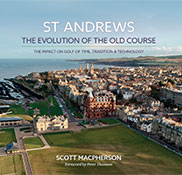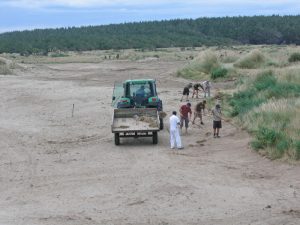GOLF CHAMPIONSHIPS ON SMGD COURSES:
At Close House – Colt Course. Sept 2017. A prestigious European Tour Championship hosted by Lee Westwood.
Broadcast worldwide from Royal Wellington Golf Club, NZ. October 2017. WOW!
The legacy continues.
Co-hosted at the award-winning Millbrook Resort near Queenstown, NZ. 2014 – 2023.
The Importance of Finishing Works
In the process of designing and building a golf course, there are many activities that contribute to the realisation of a high quality product. The routing, placement of hazards, use of materials, and the selection and supervision of contractors are some key decisions. In the physical act of golf course construction, one activity that has a major input on the outcome of the final product is the finishing works. Failure to successfully finish the subtleties of the landforms, execute the final preparation of the seedbed, and fertilise and seed appropriately, will either ensure a new design never reaches its best, or at least lengthen the time it takes to do so.
It takes the sequencing of a number of activities such as bulk earthworks, shaping, installation of drainage and irrigation before we get to the finishing works of the design, but during these processes I am always working hard to maintain the vision in my mind of how the feature, hole or course will look after completion. Doing this is somewhat of a learnt skill. What a feature looks like in subsoil or sand is different to how it will look once topsoiled, and later seeded. Features soften when being finished for seeding, and it is important to keep shapes strong and angles more sharp than dull, if they are to retain some character once completed. Grasses add a fourth dimension of texture to a 3-D design of a golf course. And visualising this during construction is just as important as the height, width and length of features.
The people responsible for finishing the golf course construction must understand the vision of the golf course architect. Tom Doak has been a high profile architect in recent years who has again proven this. By staffing his jobs with a talented project manager and several able constructional personnel, and then visiting for 10 days at a time, he can set the design direction for his crew and then be confident it will be followed – if not improved.
Like Tom Doak, I am yet to find a better method of achieving the highest quality product than by staffing the job appropriately and then providing significant periods of on-site supervision. But to reinforce the design concept during construction, my methodology is to regularly share it with the construction, grow-in and green keeping teams so all those involved feel empowered to make decisions in keeping with the vision as they proceed with the works.
In being on site, the golf architect can rally the troops and ensure important decisions that relating to the location of irrigation heads, the final approval of greens, tees and fairways prior to seeding, and seeding lines are done so. The rallying call can often be ‘use your eyes’. After a long summer in the field, it is natural that people can be getting tired. But when the last seeding windows are approaching, the construction crew must be focused and alert. When time is at a premium, it is the quality of the little decisions made by each member of the team that can really impact the final outcome. The decision may be to pull out a tree root, pick out some loose stones, remove or replace a drain or erosion fence, round off the corner of a bunker, rake around a sprinkler head or a bunker face prior to seeding, or tie in the edge of a green make a difference.
In some ways, this is the making or breaking of the course. The routing may be excellent, but if the stones have not been removed from the topsoil, then the course first opens the golfers may go away commenting on the ‘dink’ they got in the bottom of their 6-iron from the fairway. It’s the details… and this is where people are better than machine. We generally use considerable amounts of heavy machinery to build a golf course – from box-scrapers to move the earth, to large bulldozers (D8-D4) for the shaping, to tractors for the removal of stones (if present) and seeding. However, it is ultimately the hand-work that makes the final finish. Every time I am involved with the final preparation of a green, tee, fairway etc, it is strongly reinforced that no machine is better than a gang of people on rakes or spades. Smoothing out the small ruts, softening the edges of greens so the mower does scalp the ground, and picking out clumps of grass on slopes that the machine can’t reach are some of the finishing touches that separate a good finish from a great finish.
The construction of a golf course is a dynamic operation, and can and occasionally be hectic. But while the main hurdle is often weather, changing personnel, shortages of materials, and breaking machinery can cause varying degrees of consternation. So organisation is fundamental to delivering a high quality product on time and on budget. An organised project manager will have jobs assigned to the various crews and enough equipment for them to complete the task. Depending on the task, two or three people can successfully finish a green efficiently, but a team of 10 people are far more productive when it comes to finishing a fairway.
A golf course that has been finished well looks better sooner and longer. There are very few sunken trenches, the separate areas are all tied in nicely, and the green keepers can mow all the areas smoothly and efficiently. Corners must not be cut. If the architect has a strong vision and it is understood by the construction team, the finishing works are the icing on a cake that will ensure the course looks and plays its very best.
AWARDS
 Winner
Winner
Excellence in Compliance Award
Royal Wellington Golf Club
 Scott awarded by GEO as a Sustainable Golf Champion
Scott awarded by GEO as a Sustainable Golf Champion
PUBLICATIONS
 St Andrews
St Andrews
The Evolution of the Old Course
by Scott Macpherson
TESTIMONIALS
"During both the design and construction phases their can-do attitude to problem solving was refreshing".
Ben O'Malley, Millbrook Country Club, NZ




